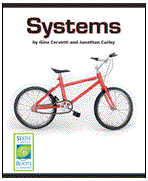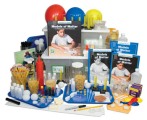Systems: Teach Students How Parts Interact to Create a Whole
July 24, 2013 at 5:42 pm Leave a comment
 A bicycle is an example of a system that students can think about to understand the the meaning of the words function and system. The information provided below gives students an overview of a system as it relates to a bicycle. Students can then use the Daily Written Reflection worksheet to reinforce what they’ve learned. This worksheet is used as part of the Seeds of Science/Roots of Reading® unit Digestion and Body Systems which uses a student book called Systems. The activity below provides the content you need from this unit to bring this activity into your classroom.
A bicycle is an example of a system that students can think about to understand the the meaning of the words function and system. The information provided below gives students an overview of a system as it relates to a bicycle. Students can then use the Daily Written Reflection worksheet to reinforce what they’ve learned. This worksheet is used as part of the Seeds of Science/Roots of Reading® unit Digestion and Body Systems which uses a student book called Systems. The activity below provides the content you need from this unit to bring this activity into your classroom.
What Makes a Wheel a Wheel
Think about a bicycle wheel. Have you ever thought about why a wheel is the way it is? It’s the structure of a wheel – the way the wheel is shaped and built – that makes it a wheel. The wheel is long and has long, thin spokes crossing in the middle. The spokes keep the wheel from bending out of shape.
Why is the structure of the wheel important? Its structure has to do with its function – what it does or what it is used for. The function of this wheel is to roll so that the bicycle can move forward. What if the wheel had a different structure. Could it still do its function? Could the wheel roll if it were shaped like a square? What if the wheel were floppy like a noodle?
A Wheel Is Just One Part of a Bicycle.
A bicycle is made up of lots of parts. One bike could have more than 100 different parts. Each part of a bicycle has a function and a structure that helps the part perform its function well. Of course, bike parts don’t do much good unless they are all put together to make a bicycle. You can’t ride just a wheel! A bicycle with all its parts connected is a system.
A system is a group of parts that interact, or work together. When the pedals on a bicycle move, they turn the gear. When the gear turns, it moves the chain. The moving chain makes the back wheel turn – and that pushes the bicycle forward. The handlebars are connected to the frame. The handlebars, frame, and front wheel all work together for steering. All the parts of a bicycle have to work together for the bicycle to work.
A Person Is a System
Explain to students that they are also a system because the human body is made of many parts that interact. All the parts of the body work together. For example, the bones in your arms are connected to muscles. The bones and muscles interact to let you move your arms. Blood vessels are tube-shaped parts that bring blood to the muscles and bones to keep them healthy and working. The heart and other parts interact to keep the blood moving to all parts of the body.
Just like bicycle parts, each part of the body has a function. The structure of each part lets the part do its function. This table shows a few body parts. For each one, it gives the structure and function.
Daily Written Reflection worksheet
Below is a worksheet to challenge students to think about the meaning of the words function and system. The table above provides examples of structures and their functions in a human system. Students should try to figure out that the function of a pedal is to move wheels on a bike so it can get from place to place. The function of eyelashes is to protect the eye from dust or dirt that might be in the air.
For more information about the student book Systems and the Digestion and Body Systems science and literacy unit, visit http://www.scienceandliteracy.org.
Do you want to be notified when we publish new blog articles? Simply enter your email address in the “Follow Blog via Email” box located in the right sidebar.
Entry filed under: Informational text, Teaching Science Concepts. Tags: 3rd grade science, 4th grade science, Digestion & Body Systems, elementary curriculum, elementary lesson plans, elementary school science, elementary science, fourth grade science, life science, science classroom, science resources, science teachers, systems, third grade science.







Trackback this post | Subscribe to the comments via RSS Feed